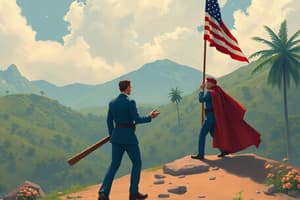Podcast
Questions and Answers
What was the Good Neighbor policy?
What was the Good Neighbor policy?
FDR's foreign policy of promoting better relations with Latin America by using economic influence rather than military force.
What did the Pan-American conferences achieve?
What did the Pan-American conferences achieve?
The U.S. pledged to never again intervene in internal Latin American affairs.
When was the Soviet Union recognized by the U.S.?
When was the Soviet Union recognized by the U.S.?
1933
What was the Tydings-McDuffie Act?
What was the Tydings-McDuffie Act?
What did reciprocal trade agreements do?
What did reciprocal trade agreements do?
What happened when Japan took Manchuria?
What happened when Japan took Manchuria?
What is the Stimson Doctrine?
What is the Stimson Doctrine?
What is fascism?
What is fascism?
Who was Benito Mussolini?
Who was Benito Mussolini?
What was the outcome of the Italian invasion of Ethiopia in 1935?
What was the outcome of the Italian invasion of Ethiopia in 1935?
What was the significance of the Munich Conference in 1938?
What was the significance of the Munich Conference in 1938?
What does 'blitzkrieg' refer to?
What does 'blitzkrieg' refer to?
What were the Neutrality Acts?
What were the Neutrality Acts?
Who was Charles Lindbergh?
Who was Charles Lindbergh?
What did FDR's quarantine speech advocate?
What did FDR's quarantine speech advocate?
What was the purpose of the Lend-Lease Act?
What was the purpose of the Lend-Lease Act?
What event occurred on December 7, 1941?
What event occurred on December 7, 1941?
What was the Manhattan Project?
What was the Manhattan Project?
What was the Holocaust?
What was the Holocaust?
What was the significance of D-Day?
What was the significance of D-Day?
What does 'island-hopping' refer to?
What does 'island-hopping' refer to?
Who was J. Robert Oppenheimer?
Who was J. Robert Oppenheimer?
What was the outcome of the Battles of Midway?
What was the outcome of the Battles of Midway?
Flashcards are hidden until you start studying
Study Notes
Foreign Policy and Relations
- Good Neighbor Policy aimed to improve relations with Latin America through economic influence rather than military force.
- Pan-American Conferences led to a pledge in 1933 not to intervene in Latin American internal affairs and a 1936 warning against German aggression in the hemisphere.
- The U.S. recognized the Soviet Union in 1933, enhancing trade and economic relations.
- Tydings-McDuffie Act of 1934 granted independence to the Philippines with a gradual U.S. withdrawal due to governance costs.
- Reciprocal Trade Agreements allowed tariff reductions to boost international trade, enabling FDR to lower tariffs by up to 50% for cooperating nations.
Rise of Fascism and Aggression
- Japan's invasion of Manchuria in 1931 violated the open-door policy and the League of Nations' authority, resulting in Japan's withdrawal from the League.
- The Stimson Doctrine asserted the U.S.'s refusal to recognize territories gained by force, echoing the League's condemnation of Japan.
- Fascism emerged with a focus on nationalism and militarism, gaining traction in Italy under Benito Mussolini, who invaded Ethiopia in 1935 despite international objections.
- The German Nazi Party, rising from post-WWI economic despair, exploited anti-Semitism and nationalistic fervor under Adolf Hitler, who became Chancellor in 1933.
World War II Developments
- Axis Powers consisted of Germany, Italy, and Japan, forming an alliance during WWII.
- The Munich Agreement of 1938 attempted to appease Hitler by allowing the annexation of Sudetenland under the promise of no further territorial expansion.
- The invasion of Poland on September 1, 1939, marked the start of war, prompting Britain and France's declaration against Germany.
American Isolationism and Support for Allies
- Isolationism limited U.S. political and military involvement internationally, with the Nye Committee investigating America's WWI entry caused by business interests.
- Neutrality Acts were gradually revised to enable increased aid to Britain amid growing war tensions.
- The America First Committee, led by isolationists like Charles Lindbergh, campaigned for non-intervention in WWII.
- FDR's Quarantine Speech (1937) suggested democracies unite against aggressors, but was met with backlash from isolationists.
- The Lend-Lease Act of 1941 facilitated arms supply to Britain on credit, countering neutrality policies.
Domestic Mobilization and Wartime Economy
- The War Production Board converted civilian industry to military production, tripling manufacturing output.
- Price controls and rationing were implemented by the Office of Price Administration to curb inflation and support wartime efforts.
- Federal spending soared, resulting in a significant increase in GDP and a massive war-related national debt.
Social Changes and Civil Rights
- Wartime migration saw millions from rural areas moving into cities for factory work.
- Racial tensions culminated in race riots during summer 1943, highlighting the fight for civil rights through campaigns like "Double V".
- Executive Order 8802 banned discrimination in federal defense contracts, a step toward racial equality.
- The Braceros program allowed Mexican workers to enter the U.S. during harvest seasons, leading to conflicts over perceived job competition.
The WWII Military Campaigns
- D-Day, on June 6, 1944, resulted in a critical Allied landing in Normandy, marking a turning point in European theater.
- The Battle of Midway (June 1942) significantly curbed Japanese expansion, while strategies like island-hopping aimed to capture key Japanese-held islands.
- Strategic bombing campaigns targeted German cities and military objectives, impacting civilian populations in both Europe and Japan.
The Atomic Age and Post-War Developments
- The Manhattan Project aimed to develop the atomic bomb, overseen by J. Robert Oppenheimer.
- Hiroshima and Nagasaki were bombed in August 1945, leading to Japan's quick surrender and marking the first use of nuclear weapons in conflict.
- The Big Three (U.S., Soviet Union, Great Britain) coordinated war strategies and post-war plans through major conferences, ultimately leading to the establishment of the United Nations.
Conclusion
- The era was marked by significant shifts in foreign policy, the rise of fascism, America's reluctant entry into WWII, and profound social changes—all contributing to the modern geopolitical landscape.
Studying That Suits You
Use AI to generate personalized quizzes and flashcards to suit your learning preferences.




